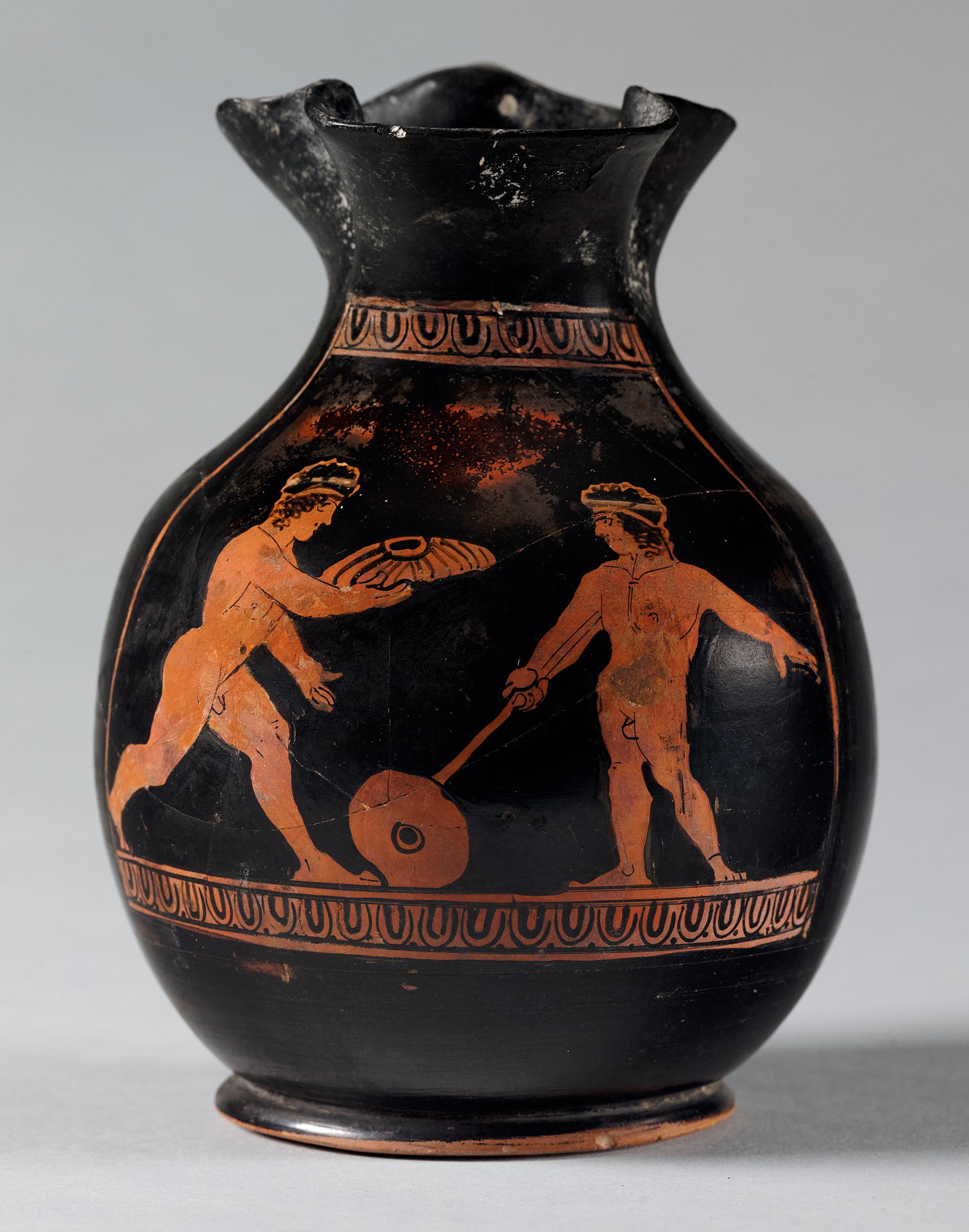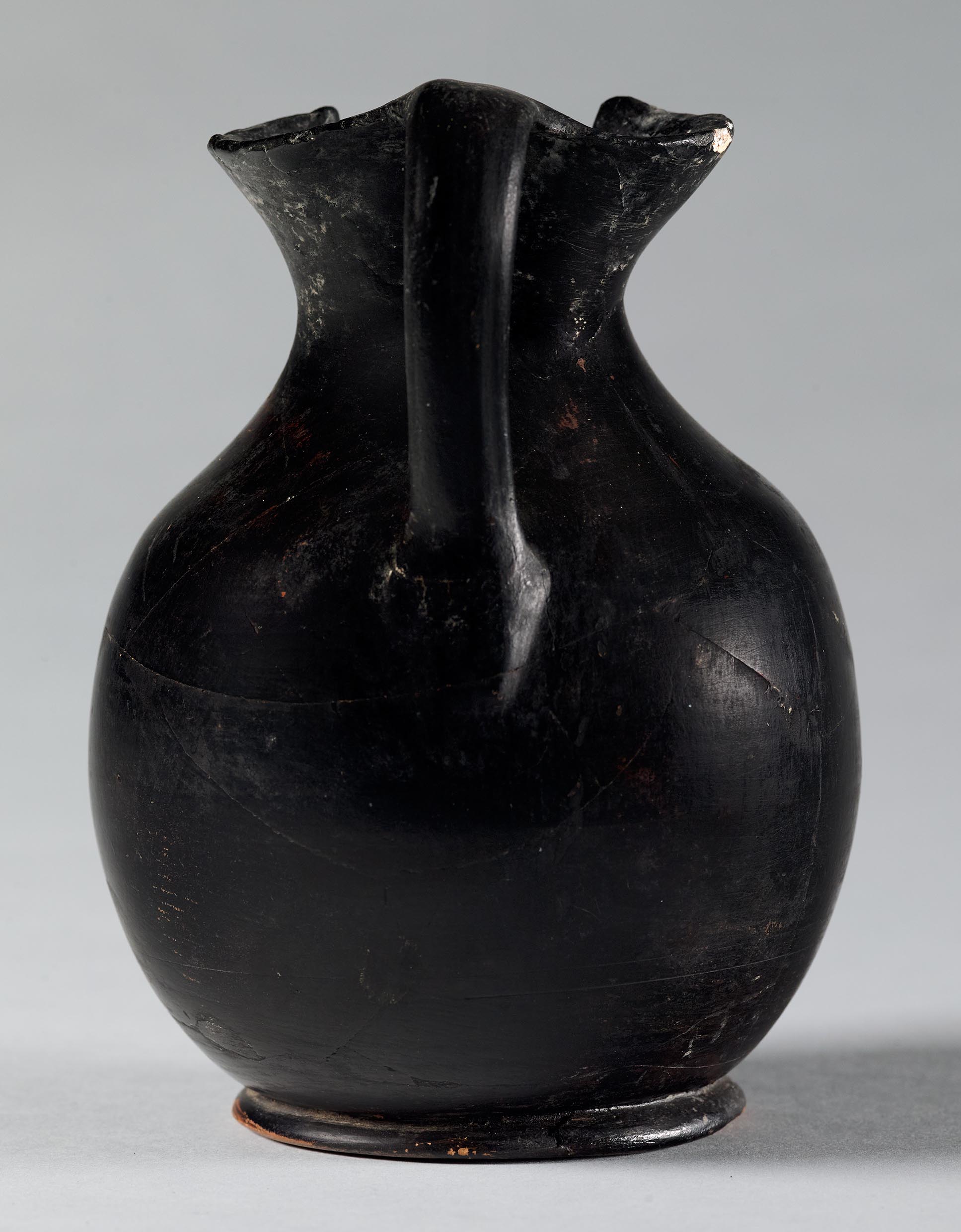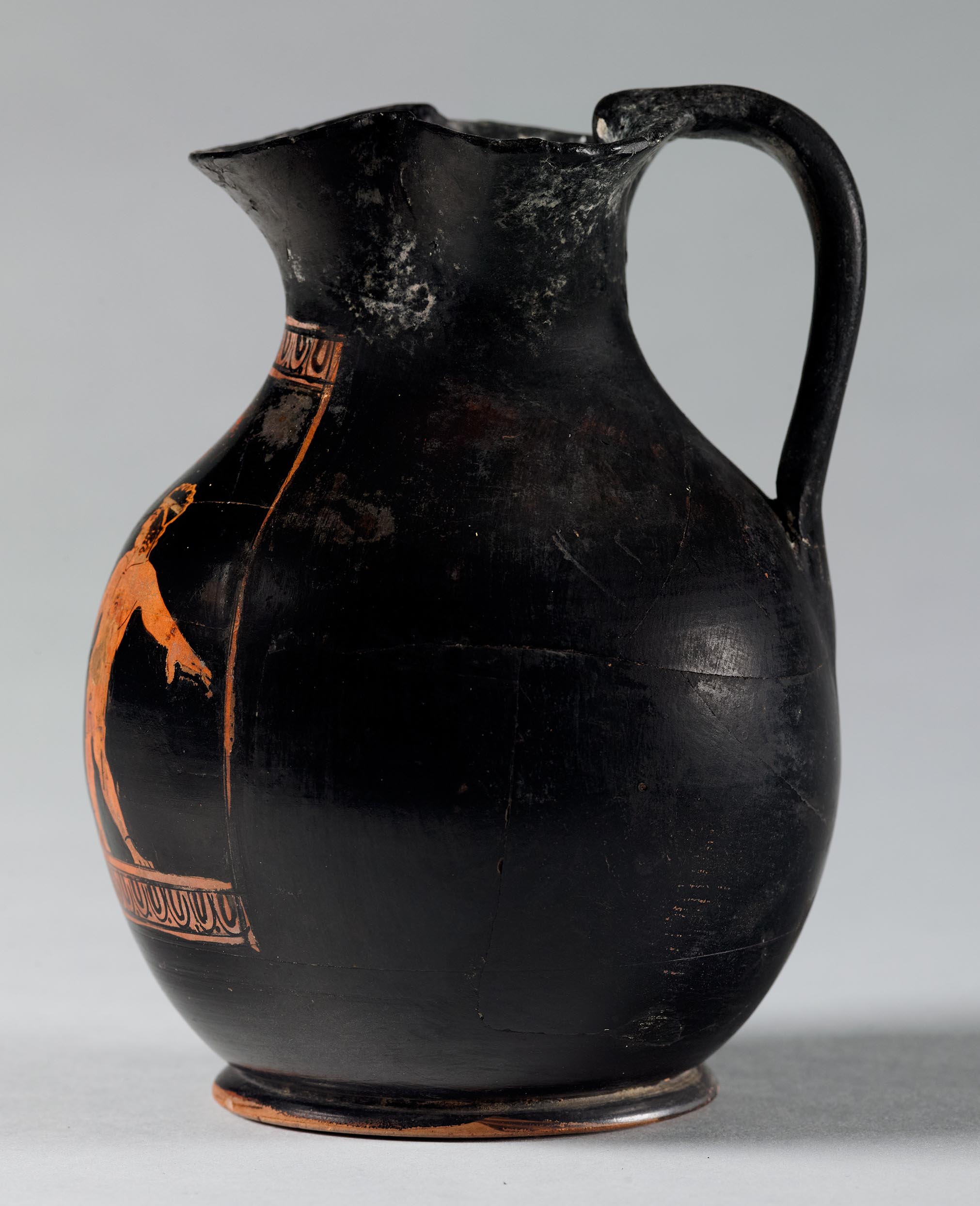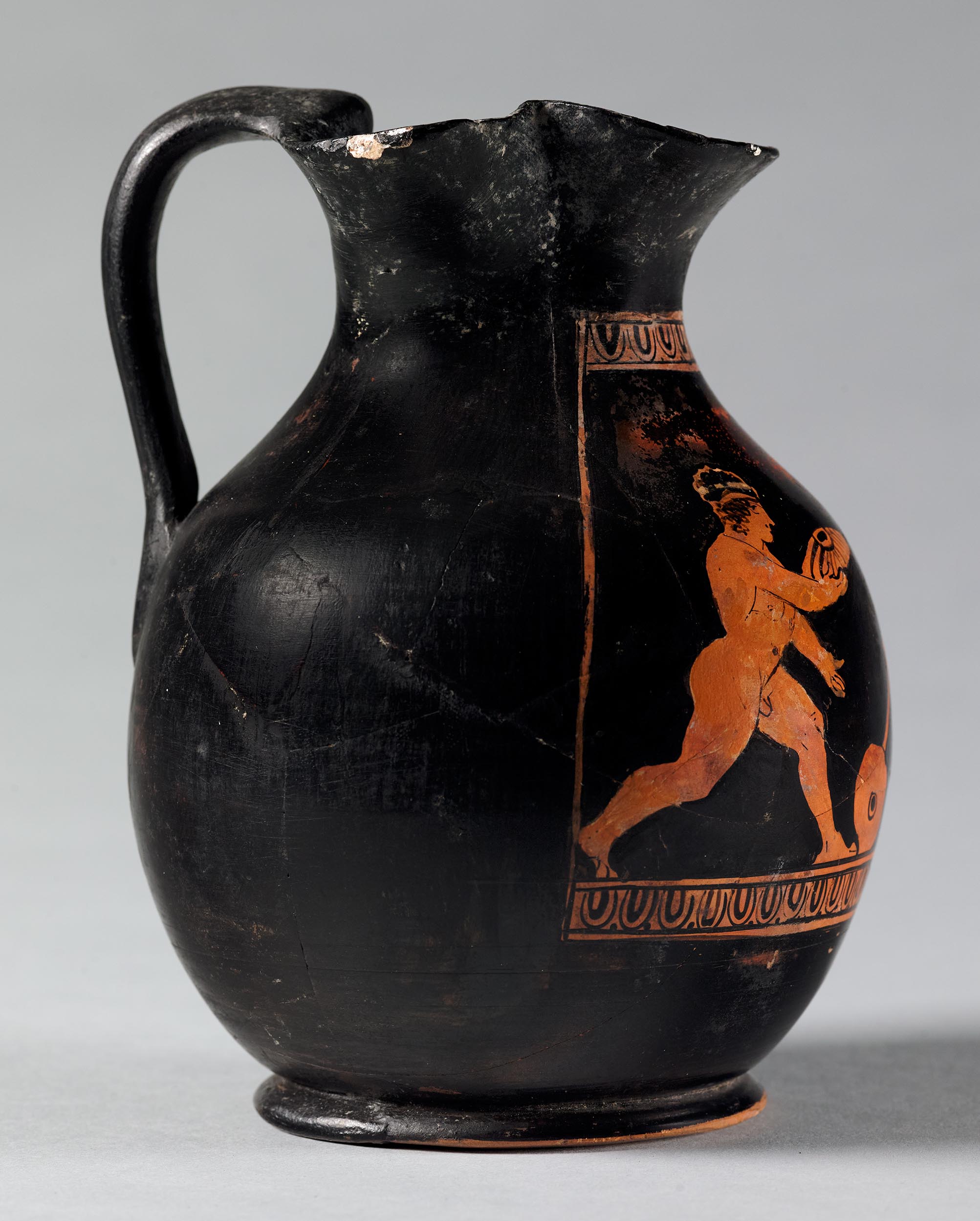Provenance
1962, bequest, George Rowley to Princeton University.
Shape and Ornament
Miniature in size, with continuous curve from mouth to foot. Trefoil mouth. Interior of neck black. Black vertical handle, round in section. Globular body. Figure panel bordered above and below by ovolo, and at the sides by reserved bands. Low ring base; lower section of base reserved; underside coated with reddish miltos.
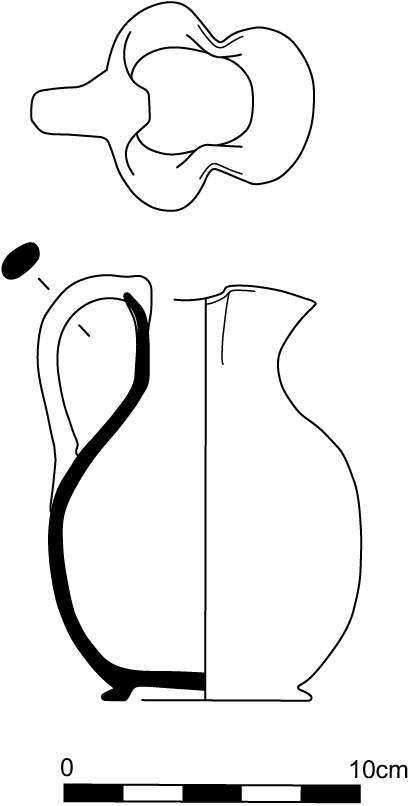
Subject
Two nude boys facing each other. The boy at the left runs in profile to the right, carrying an omphalos cake in his outstretched right hand. Both his legs are slightly flexed at the knees. His right arm raises the omphalos cake while his left extends diagonally downward with his hand open. The boy at the right stands facing left, with his torso in three-quarter view and his head in profile. His straight right leg is in profile while his left leg is slightly bent and frontal in a relaxed contrapposto pose. He grasps a roller, a stick with a wheel on its end, in his right hand and extends his left arm to the opposite side for balance. Both figures wear fillets, underneath which flow curls of long hair.
Attribution and Date
Unattributed. Circa 420–410 BCE.
Dimensions and Condition
h. 14.4 cm; diam. 10.6 cm; diam. of mouth (lateral) 7.1 cm; diam. of mouth (back to front) 6.1 cm; diam. of foot 7.2 cm. Broken and mended. Handle reattached. Much of the front lobe of the trefoil mouth restored, with small chips revealing white plaster. Much of the waist of the boy at the left repainted. Section of the panel above and between the two figures misfired splotchy red.
Technical Features
Preliminary sketch. Accessory color. White: fillets. Fillets also executed in relief.
Bibliography
R. Hamilton, Choes and Anthesteria: Athenian Iconography and Ritual (Ann Arbor, MI, 1992), fig. 18; Abbreviation: Neils and Oakley, Coming of AgeNeils, J., and J. H. Oakley. 2003. Coming of Age in Ancient Greece: Images of Childhood from the Classical Past. Exhibition catalogue. Hood Museum of Art, Dartmouth College. Hanover, NH., 146 [illus.], 287, no. 101; K. Gkounkoulé and D. Karakatsané, eds., Το ελληνικό παιχνίδι: Διαδρομές στην ιστορία του (Athens, 2008), 52, fig. 22; Abbreviation: BAPDBeazley Archive Pottery Database. http://www.beazley.ox.ac.uk 21462.
Comparanda
For the style of drawing, cf. Athens 1555 (G. van Hoorn, Choes and Anthesteria [Leiden, 1951], no. 50, fig. 255; Abbreviation: BAPDBeazley Archive Pottery Database. http://www.beazley.ox.ac.uk 16513), which Neils and Oakley (Coming of Age, 287) suggest may be by the same hand. For the shape and its connection with the Anthesteria, see Princeton y1953-22 (Entry 38). The omphalos cake was an important aspect of the Anthesteria. In the Choes, the contest that took place on the second day of the festival, the first man to finish his chous of wine received a cake as a prize. Although the type of cake depicted on choes differs widely, the most common is the omphalos cake, with a knob in the center from which wedges radiate, as on Princeton’s: cf. Athens 15875 (van Hoorn, Choes and Anthesteria, fig. 24, no. 111; Abbreviation: BAPDBeazley Archive Pottery Database. http://www.beazley.ox.ac.uk 1072). For the iconography of the cake and its significance in the Anthesteria, see van Hoorn, Choes and Anthesteria, 41–44. Although children would not have been awarded an omphalos cake at the festival, scenes of the cake in combination with children could function as an iconographic reference to future Choes contests in which the children would partake, or could simply suggest that children at the festival were attracted to such treats: see Hamilton, Choes and Anthesteria, 117.
As van Hoοrn noted, it is often difficult to distinguish an amaxis (toy roller) from a small cart in profile, the latter often used by children on choes to transport cakes or choes: cf., for a cart, Brunswick 1915.38 (van Hoorn, Choes and Anthesteria, fig. 89, no. 397; Abbreviation: BAPDBeazley Archive Pottery Database. http://www.beazley.ox.ac.uk 15996); for a toy roller, Leiden KVB 64 (van Hoorn, Choes and Anthesteria, fig. 80, no. 615; Abbreviation: BAPDBeazley Archive Pottery Database. http://www.beazley.ox.ac.uk 15980). If it is a cart, its small size suggests that it is a miniaturized or toy version of the wagons used during the Choes, on which male revelers travel as part of the festival.
